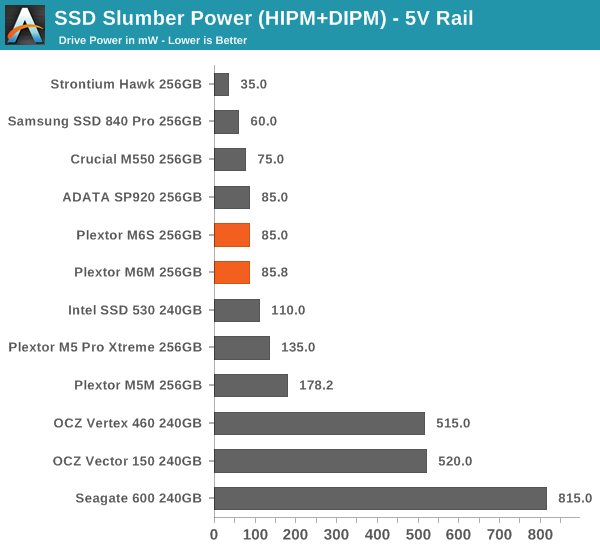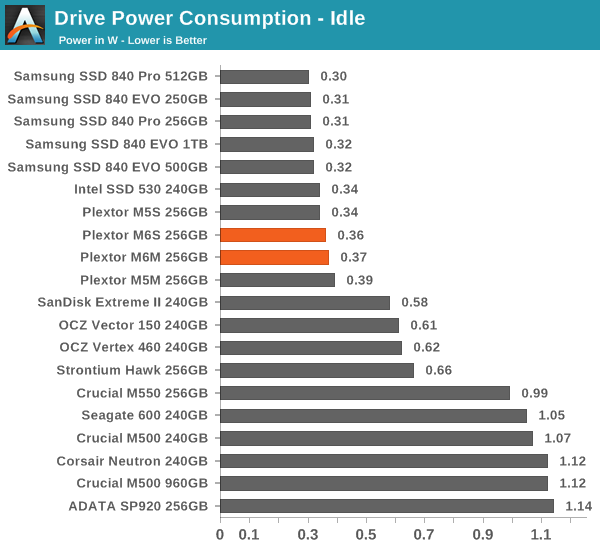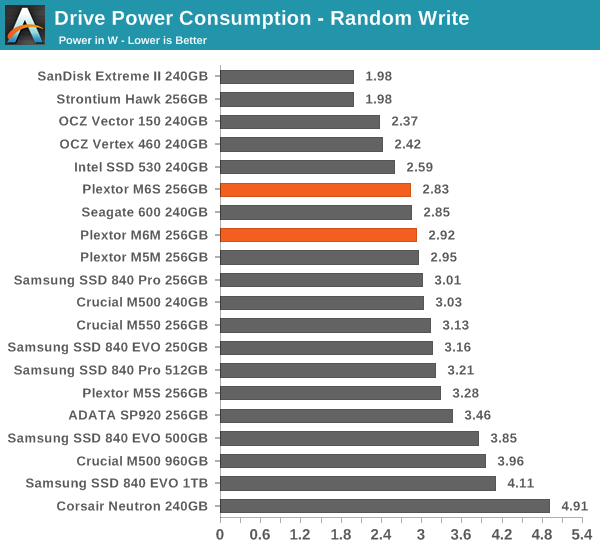Plextor M6S & M6M (256GB) Review
by Kristian Vättö on April 10, 2014 6:00 AM ESTPower Consumption
In the ADATA SP920 review, I mentioned that I finally was collecting slumber power numbers for all the drives I have tested, but I hadn't tested enough drives to meet the strict deadline for the SP920 review. I now have the numbers to share. I'm only including the most relevant drives here but you can find all the results in out Bench.
Note that these results differ from the ones Anand has published earlier due to the fact that we are using totally different testbeds. Anand is using a modified laptop and only measures the current on the 3.3V rail, whereas I'm using our 2014 SSD testbed, which is a desktop system. I was surprised that the system even supported HIPM+DIPM as traditionally those are mobile-only features, but with aggressive link power management enabled in the BIOS, I was able to get them to work on a desktop as well. Unfortunately my multimeter only supports current measurement at the accuracy of one milliamp, so the results go in multiples of five (0.001A*5V is 5mW, so that's the smallest increment).
The M6S and M6M do pretty well here. Out of the drives that support low power states, the M6S and M6M are mediocre, but having the support is more important than the actual numbers. Whether the drive consumes 80mW or 40mW at idle won't make a huge difference to the battery life but 80mW vs 800mW certainly does. Both drives also support DevSleep and Plextor claims power consumption as low as 2mW but unfortunately we don't have the tools to test that yet (it is in the works, though).
Power consumption under load is also very good. The days of super power hungry SSDs are fortunately over and most drives stay easily below 4W, but keeping below 3W in all cases is still quite rare.














30 Comments
View All Comments
Kristian Vättö - Friday, April 11, 2014 - link
Yes, there will be a review of the M6e. There has been some issues with testing and hence it's taking this long but it'll be my first priority as soon as we are able to overcome the issues.n3cw4rr10r - Thursday, April 10, 2014 - link
The prices for SSDs are still high imo. I am surprised they are still holding @ approx $1/gb in most cases.philipma1957 - Thursday, April 10, 2014 - link
samsung evo is far below $1 a gb and crucial M550's are far below $1 a gbssj3gohan - Thursday, April 10, 2014 - link
Finally actual proper idle power consumption results! It only took you a bit more than 5 years!HIPM and DIPM have been supported on all desktop systems - all desktop OSes as well as all hardware platforms - since the Athlon 64 X2 and first generation Core 2 (i945 chipset) times. I have been measuring SSD power consumption since they first came out - and yes, ever since the first SSDs, most of them supported the full gamut of power management - and have always been baffled that no review site on the internet has ever published accurate idle power consumption data. You are - aside from a few blogs I have come across - the first one. Congratulations!
Now, it's true that the first instances of especially DIPM were frought with latency issues and for a long time DIPM was turned off by default on Linux kernels (although Windows always forces it on in anything but the 'performance' power profile since Vista). Also, and this is probably the biggest issue, lots of BIOSes do not properly report SATA LPM or have it off by default. As it is usually fairly well hidden away it is not something many people think to turn on.
SATA ALPM is not at all a mobile feature. It has never been. Since support was baked in it has always been available to both laptop and desktop users. And with SSDs spending >>99% in idle, it represents easy and harmless power savings both in the SSD as well as the SATA I/O on the motherboard.
zodiacsoulmate - Thursday, April 10, 2014 - link
wow nice info!chubbypanda - Friday, April 11, 2014 - link
That's right. I always wondered why SSD reviewers at AnandTech claim it's mobile only. It's available at least on Denlow platform for sure.By the way, HIPM/DIPM feature itself is easy to control in Windows with simple registry update:
https://communities.intel.com/message/225489
Kristian Vättö - Friday, April 11, 2014 - link
"Also, and this is probably the biggest issue, lots of BIOSes do not properly report SATA LPM or have it off by default."That is the issue I had previously. The motherboard in my old testbed doesn't have the option to enable link power management and hence I couldn't perform those tests.
Ethos Evoss - Thursday, April 10, 2014 - link
Don't understand your tests ...It is all bollocks.. so few months back M5M was best and now it is on bottom ? that is all BULLCRAP
DanNeely - Thursday, April 10, 2014 - link
The M5M was reviewed a year ago. It's performance was underwhelming compared to sata drives then; but at the time getting an mSata drive at retail was much easier said than done; and at the time it was still a reasonable buy for its money. Since then much better mSata drives have came out and Plextor is trying to charge a premium device price while providing performance much worse than that of competing products that are significantly cheaper.http://anandtech.com/show/6722/plextor-m5m-256gb-m...
Ethos Evoss - Thursday, April 10, 2014 - link
Then M6M is NOT big step from M5M .. I have 2x M5M 256GB and they fliesI am not replacing then .. not worth ..